Hollow-Core Photonic Crystal Fiber Gas Sensing
Abstract
:1. Introduction
2. Basic Principles of Fiber Gas Sensing
2.1. Absorption Spectroscopy
2.2. Raman Spectroscopy
2.3. Photothermal Spectroscopy
2.4. Photoacoustic Spectroscopy
3. SC-PCFs and HC-PCFs
- Up to 99% of the total transmission power can be confined in the hollow core [70], improving the sensing sensitivity.
- The light–gas overlap in the fiber is significantly increased, and thereby the fiber length can be greatly reduced, improving the response speed.
- The light confined in the core is less affected by the fiber material in the cladding. Furthermore, HC-PCFs possess advanced features of low nonlinearity, short delay, high damage threshold, and good thermal stability.
4. Structures and Properties of HC-PCFs
5. Configurations of Gas Sensing in HC-PCFs
5.1. HC-PCFs with Gas Infiltrated from Fiber Ends
5.2. HC-PCFs with Gas Access from Fiber Sides
6. MIR HC-ARF Gas Sensors
7. Conclusions
Author Contributions
Funding
Conflicts of Interest
Appendix A
| Gas | Wavelength | Sensing Principle | Type of Fiber/Length | Response or Averaging Time/Assisted Pressure | Detection Limit | Ref. |
|---|---|---|---|---|---|---|
| Acetylene(C2H2) | 1510–1540 nm | DAS 1 | HC-PBGF/ 5 m | 240 s/ 0.7 bar | Not stated | [20] |
| 1528.03 nm | DAS | HC-PBGF/ 2 m | Sub minute/ <1 bar | <100 ppm | [61] | |
| 1500–1550 nm | DAS | HC-PBGF/ 0.33 m | several minutes/ several bar | Not stated | [144] | |
| 1530.1–1530.7 nm | WMS 2 | HC-PBGF/ 13 m | Not stated | <1 ppm | [120] | |
| 1530.371 nm | PTS 3 | HC-PBGF/ 0.62 m | Not stated | 2 ppb | [89] | |
| 1510–1545 nm | DAS | suspended ring-core PCF/ 0.25 m | 8.7 min/ 0.5 bar | Not stated | [63] | |
| 1532.83 nm | WMS | HC-PBGF/ 0.094 m | Not stated | 7 ppm | [84] | |
| 1514–1538 nm | DAS | HC-PBGF/ 1 m | 4 s/ 113 mbar | Not stated | [82] | |
| 1518.71 nm | DAS | HC-PBGF/ 0.9 m | 20 min/ 0.1 bar | 500 ppm | [85] | |
| Methane (CH4) | 1315–1345 nm | DAS | HC-PBGF/ 1 m | 4 s/ 113 mbar | Not stated | [82] |
| ~1666 nm | WMS | HC-PBGF/ 0.137 m | 248 s/ not stated | 158 ppm | [19] | |
| 1665.48 nm | DAS | HC-PBGF/ 0.07 m | 3 s/ 0.1 bar | 647 ppm | [91] | |
| 3.19–3.36 μm | FTS 4 | HC-PBGF/ 0.8 m | 2 min/ 2 bar | 50 ppm | [83] | |
| 3.33 μm | WMS | HC-ARF/ 1.3 m | <10 s/ 1.1 bar | Single ppm | [65] | |
| 3.33 μm | CLDS 5 | HC-ARF/ 1.3 m | 1 s/ 1.1 bar | 500 ppb | [66] | |
| Ammonia (NH3) | 1500 nm | DAS | HC-PBGF/ 1 m | 4 s/ 113 mbar | Not stated | [82] |
| 1531.7 nm | DAS | HC-PBGF/ 1 m | Not stated | 20 ppm | [88] | |
| Nitrogen (N2) | 584.5 nm | SRCS 6 | HC-PBGF/ 1.5 m | 36 s/ 6.9 bar | Not stated | [36] |
| 313–833 nm | RCS 7 | HC-PBGF/ 0.3 m | 10 s/ not stated | Not stated | [86] | |
| Oxygen (O2) | 559 nm | SRCS | HC-PBGF/ 1.5 m | 36 s/ 6.9 bar | Not stated | [36] |
| 313–833 nm | RCS | HC-PBGF/ 0.3 m | 10 s/ not stated | Not stated | [86] | |
| Propane (C3H8) | 535–545 nm 600–610 nm | SRCS | HC-PBGF/ 1.5 m | 36 s/ 6.9 bar | Not stated | [36] |
| Ethane (C2H6) | 535–545 nm 600–610 nm | SRCS | HC-PBGF/ 1.5 m | 36 s/ 6.9 bar | Not stated | [36] |
| Carbon dioxide (CO2) | 417–714 nm | RCS | HC-PBGF/ 0.3 m | 3 min/ not stated | 400 ppm | [86] |
| Toluene (C7H8) | 313–1000 nm | RCS | HC-PBGF/ 0.3 m | 10 s/ not stated | 400 ppm | [86] |
| Acetone (C3H6O) | 313–455 nm | RCS | HC-PBGF/ 0.3 m | 10 s/ not stated | 100 ppm | [86] |
| 1,1,1-trichloroethane (1,1,1-C2H3Cl3) | 313–455 nm | RCS | HC-PBGF/ 0.3 m | 60 s/ not stated | 12000 ppm | [86] |
| Hydrogen cyanide (HCN) | 1530–1542 nm | DAS | HC-PBGF/ 1 m | 4 s/ 113 mbar | Not stated | [82] |
| Hydrogen (H2) | 1532.2 nm | SRGS 8 | HC-PBGF/ 15 m | 250 s/ 1.6 bar | 17 ppm | [38] |
| Carbon monoxide (CO) | 2.3 μm | WMS | HC-ARF/ 0.85 m | 5 s/ 1.8 bar | 0.4 ppm | [95] |
| Nitrous oxide (N2O) | 3.6 μm | DAS | HC-ARF/ 1.2 m | Not stated | 35 ppm | [94] |
| 4.53 μm | WMS | HC-ARF/ 3.2 m | 23 s/ 0.94 bar | Single ppb | [67] |
References
- Allen, M.G. Diode laser absorption sensors for gas-dynamic and combustion flows. Meas. Sci. Technol. 1998, 9, 545–562. [Google Scholar] [CrossRef] [Green Version]
- Laj, P.; Klausen, J.; Bilde, M.; Plaß-Duelmer, C.; Pappalardo, G.; Clerbaux, C.; Baltensperger, U.; Hjorth, J.; Simpson, D.; Reimann, S.; et al. Measuring atmospheric composition change. Atmos. Environ. 2009, 43, 5351–5414. [Google Scholar] [CrossRef]
- Stewart, C.M.; Aminossadati, S.M.; Kizil, M.S. Predictive network modelling with live sensor data. In Proceedings of the 2017 2nd International Conference for Fibre-optic and Photonic Sensors for Industrial and Safety Applications (OFSIS), Brisbane, QLD, Australia, 8–10 January 2017; pp. 63–69. [Google Scholar] [CrossRef]
- Smith, D.; Spanel, P. The challenge of breath analysis for clinical diagnosis and therapeutic monitoring. Analyst 2007, 132, 390–396. [Google Scholar] [CrossRef] [PubMed]
- Moseley, P.T. Solid state gas sensors. Meas. Sci. Technol. 1997, 8, 223–237. [Google Scholar] [CrossRef]
- Shimizu, Y.; Egashira, M. Basic aspects and challenges of semiconductor gas sensors. MRS Bull. 1999, 24, 18–24. [Google Scholar] [CrossRef]
- Bakker, E.; Telting-Diaz, M. Electrochemical Sensors. Anal. Chem. 2002, 74, 2781–2800. [Google Scholar] [CrossRef]
- Lexer, F.; Hitzenberger, C.K.; Fercher, A.; Kulhavy, M. Wavelength-tuning interferometry of intraocular distances. Appl. Opt. 1997, 36, 6548–6553. [Google Scholar] [CrossRef]
- De Groot, P. Measurement of transparent plates with wavelength-tuned phase-shifting interferometry. Appl. Opt. 2000, 39, 2658–2663. [Google Scholar] [CrossRef]
- Anderson, D.Z.; Frisch, J.C.; Masser, C.S. Mirror reflectometer based on optical cavity decay time. Appl. Opt. 1984, 23, 1238–1245. [Google Scholar] [CrossRef]
- O’Keefe, A.; Deacon, D.A. Cavity ring-down optical spectrometer for absorption measurements using pulsed laser sources. Rev. Sci. Instrum. 1988, 59, 2544–2551. [Google Scholar] [CrossRef] [Green Version]
- Shi, G.; Wang, W.; Zhang, F. Precision improvement of frequency-modulated continuous-wave laser ranging system with two auxiliary interferometers. Opt. Commun. 2018, 411, 152–157. [Google Scholar] [CrossRef]
- Niell, A.; Barrett, J.; Burns, A.; Cappallo, R.; Corey, B.; Derome, M.; Eckert, C.; Elosegui, P.; McWhirter, R.; Poirier, M.; et al. Demonstration of a broadband very long baseline interferometer system: A new instrument for high-precision space geodesy. Radio Sci. 2018, 53, 1269–1291. [Google Scholar] [CrossRef] [Green Version]
- Alberto, N.J.; Domingues, M.F.; Belo, J.H.; Marques, C.; Antunes, P.; Amaral, V.; André, P.; Lieberman, R.A.; Baldini, F.; Homola, J. Optical fibre fuse effect based sensor for magnetic field monitoring. In Proceedings of the SPIE OPTICS + OPTOELECTRONICS, Prague, Czech Republic, 1–4 April 2019; Volume 110281S. [Google Scholar] [CrossRef]
- De, M.; Gangopadhyay, T.K.; Singh, V.K. Prospects of photonic crystal fiber for analyte sensing applications: An overview. Meas. Sci. Technol. 2020, 31, 042001. [Google Scholar] [CrossRef]
- Lehmann, H.; Brueckner, S.; Kobelke, J.; Schwotzer, G.; Schuster, K.; Willsch, R. Toward photonic crystal fiber based distributed chemosensors. In Proceedings of the 17th International Conference on Optical Fibre Sensors, Bruges, Belgium, 23–27 May 2005; Volume 5855, pp. 419–422. [Google Scholar] [CrossRef]
- Lin, Y.; Liu, F.; He, X.; Jin, W.; Zhang, M.; Yang, F.; Ho, H.L.; Tan, Y.; Gu, L. Distributed gas sensing with optical fibre photothermal interferometry. Opt. Express 2017, 25, 31568–31585. [Google Scholar] [CrossRef]
- Culshaw, B.; Stewart, G.; Dong, F.; Tandy, C.; Moodie, D. Fibre optic techniques for remote spectroscopic methane detection-from concept to system realisation. Sens. Actuat. B Chem. 1998, 51, 25–37. [Google Scholar] [CrossRef]
- Carvalho, J.P.; Lehmann, H.; Bartelt, H.; Magalhães, F.; Amezcua-Correa, R.; Santos, J.L.; Roosbroeck, J.V.; Araújo, F.M.; Ferreira, L.A.; Knight, J.C. Remote system for detection of low-levels of methane based on photonic crystal fibres and wavelength modulation spectroscopy. J. Sens. 2009, 2009, 1–10. [Google Scholar] [CrossRef]
- Do Lim, S.; Ma, K.; Jeong, J.H.; Kim, G.; Lee, K.; Jeong, J.-M.; Lee, S.B. In situ gas sensing using a remotely detectable probe with replaceable insert. Opt. Express 2012, 20, 1727–1732. [Google Scholar] [CrossRef]
- Tiwari, U.; Thyagarajan, K.; Shenoy, M.R.; Jain, S.C. EDF-based edge-filter interrogation scheme for FBG sensors. IEEE Sens. J. 2013, 13, 1315–1319. [Google Scholar] [CrossRef]
- Díaz, C.A.R.; Marques, C.A.F.; Domingues, M.F.F.; Ribeiro, M.R.N.; Frizera-Neto, A.; Pontes, M.J.; André, P.S.; Antunes, P.F.C. A cost-effective edge-filter based FBG interrogator using catastrophic fuse effect micro-cavity interferometers. Measurement 2018, 124, 486–493. [Google Scholar] [CrossRef]
- Silveira, P.C.; Dante, A.; Keley, M.M.; Carvalho, C.; Allil, R.; Mok, R.; Garcao, L.; Werneck, M. Experimental evaluation of low-cost interrogation techniques for FBG sensors. In Proceedings of the 2018 IEEE International Instrumentation and Measurement Technology Conference (I2MTC), Houston, TX, USA, 14–17 May 2018; pp. 1–6. [Google Scholar] [CrossRef]
- Diaz, C.A.R.; Leitao, C.; Marques, C.A.; Domingues, M.F.; Alberto, N.; Pontes, M.J.; Frizera, A.; Ribeiro, M.R.N.; Andre, P.S.B.; Antunes, P.F.C. Low-cost interrogation technique for dynamic measurements with FBG-based devices. Sensors 2017, 17, 2414. [Google Scholar] [CrossRef] [Green Version]
- Kurohiji, M.; Ichiriyama, S.; Yamasaku, N.; Okazaki, S.; Kasai, N.; Maru, Y.; Mizutani, T. A robust fiber Bragg grating hydrogen gas sensor using platinum-supported silica catalyst film. J. Sens. 2018, 2018, 1–8. [Google Scholar] [CrossRef]
- Bin, Z.; Zhuo, C.; Yebin, Z.; Shaorui, G.; Sailing, H. Active fiber gas sensor for methane detecting based on a laser heated fiber Bragg grating. IEEE Photon. Technol. Lett. 2014, 26, 1069–1072. [Google Scholar] [CrossRef]
- Shivananju, B.N.; Yamdagni, S.; Fazuldeen, R.; Sarin Kumar, A.K.; Hegde, G.M.; Varma, M.M.; Asokan, S. CO2 sensing at room temperature using carbon nanotubes coated core fiber Bragg grating. Rev. Sci. Instrum. 2013, 84, 065002. [Google Scholar] [CrossRef] [PubMed] [Green Version]
- Ai, L.; Mau, J.-C.; Liu, W.-F.; Fu, M.-Y.; Chen, T.-C. Ammonia gas fiber sensor based on poly-aniline sensing film coated on superstructure fiber Bragg gratings. Microw. Opt. Technol. Lett. 2007, 49, 3063–3066. [Google Scholar] [CrossRef]
- Wen, H.-Y.; Wang, S.-H.; Tsai, L.; Hsu, R.-Y.; Chiang, C.-C. Advanced NO sensors on notched long-period fiber gratings covered by mesoporous WO3. IEEE Sens. J. 2020, 20, 4595–4601. [Google Scholar] [CrossRef]
- Esposito, F.; Zotti, A.; Ranjan, R.; Zuppolini, S.; Borriello, A.; Campopiano, S.; Zarrelli, M.; Iadicicco, A. Single-ended long period fiber grating coated with polystyrene thin film for butane gas sensing. J. Lightwave Technol. 2018, 36, 825–832. [Google Scholar] [CrossRef]
- Melo, L.; Burton, G.; Davies, B.; Risk, D.; Wild, P. Highly sensitive coated long period grating sensor for CO2 detection at atmospheric pressure. Sens. Actuat. B Chem. 2014, 202, 294–300. [Google Scholar] [CrossRef]
- Wang, T.; Korposh, S.; James, S.; Tatam, R.; Lee, S.-W. Optical fiber long period grating sensor with a polyelectrolyte alternate thin film for gas sensing of amine odors. Sens. Actuat. B Chem. 2013, 185, 117–124. [Google Scholar] [CrossRef]
- Gu, Z.; Xu, Y.; Gao, K. Optical fiber long-period grating with solgel coating for gas sensor. Opt. Lett. 2006, 31, 2405–2407. [Google Scholar] [CrossRef]
- Hodgkinson, J.; Tatam, R.P. Optical gas sensing: A review. Meas. Sci. Technol. 2012, 24, 012004. [Google Scholar] [CrossRef] [Green Version]
- Inaba, H.; Kobayasi, T.; Hirama, M.; Hamza, M. Optical-fibre network system for air-pollution monitoring over a wide area by optical absorption method. Electron. Lett. 1979, 15, 749–751. [Google Scholar] [CrossRef]
- Buric, M.P.; Chen, K.P.; Falk, J.; Woodruff, S.D. Enhanced spontaneous Raman scattering and gas composition analysis using a photonic crystal fiber. Appl. Opt. 2008, 47, 4255–4261. [Google Scholar] [CrossRef] [PubMed] [Green Version]
- Hanf, S.; Keiner, R.; Yan, D.; Popp, J.; Frosch, T. Fiber-enhanced Raman multigas spectroscopy: A versatile tool for environmental gas sensing and breath analysis. Anal. Chem. 2014, 86, 5278–5285. [Google Scholar] [CrossRef] [PubMed]
- Yang, F.; Jin, W. All-fiber hydrogen sensor based on stimulated Raman gain spectroscopy with a 1550 nm hollow-core fiber. In Proceedings of the 2017 25th Optical Fiber Sensors Conference (OFS), Jeju, Korea, 24–28 April 2017; pp. 1–4. [Google Scholar] [CrossRef]
- Yang, F.; Tan, Y.; Jin, W.; Lin, Y.; Qi, Y.; Ho, H.L. Hollow-core fiber Fabry-Perot photothermal gas sensor. Opt. Lett. 2016, 41, 3025–3028. [Google Scholar] [CrossRef]
- Peng, Y.; Zhang, W.; Li, L.; Yu, Q. Tunable fiber laser and fiber amplifier based photoacoustic spectrometer for trace gas detection. Spectrochim Acta. A. 2009, 74, 924–927. [Google Scholar] [CrossRef]
- Wu, H.; Dong, L.; Liu, X.; Zheng, H.; Yin, X.; Ma, W.; Zhang, L.; Yin, W.; Jia, S. Fiber-amplifier-enhanced QEPAS sensor for simultaneous trace gas detection of NH3 and H2S. Sensors 2015, 15, 26743–26755. [Google Scholar] [CrossRef] [Green Version]
- Jin, W.; Ho, H.L.; Cao, Y.C.; Ju, J.; Qi, L.F. Gas detection with micro- and nano-engineered optical fibers. Opt. Fiber Technol. 2013, 19, 741–759. [Google Scholar] [CrossRef] [Green Version]
- He, X.; Rechnitz, G.A. Linear response function for fluorescence-based fiber-optic CO2 sensors. Anal. Chem. 1995, 67, 2264–2268. [Google Scholar] [CrossRef]
- Abdelghani, A.; Chovelon, J.M.; Jaffrezic-Renault, N.; Ronot-Trioli, C.; Veillas, C.; Gagnaire, H. Surface plasmon resonance fibre-optic sensor for gas detection. Sens. Actuat. B Chem. 1997, 39, 407–410. [Google Scholar] [CrossRef]
- Villatoro, J.; Monzón-Hernández, D. Fast detection of hydrogen with nano fiber tapers coated with ultra thin palladium layers. Opt. Express 2005, 13, 5087–5092. [Google Scholar] [CrossRef]
- Stewart, G.; Jin, W.; Culshaw, B. Prospects for fibre-optic evanescent-field gas sensors using absorption in the near-infrared. Sens. Actuat. B Chem. 1997, 38, 42–47. [Google Scholar] [CrossRef]
- Tseng, S.-M.; Chen, C.-L. Side-polished fibers. Appl. Opt. 1992, 31, 3438–3447. [Google Scholar] [CrossRef]
- Monro, T.M.; Richardson, D.J.; Bennett, P.J. Developing holey fibres for evanescent field devices. Electron. Lett. 1999, 35, 1188–1189. [Google Scholar] [CrossRef]
- Hoo, Y.L.; Jin, W.; Ho, H.L.; Wang, D.N.; Windele, R.S. Evanescent wave gas sensing using microstructure fibre. In Proceedings of the Technical Digest. CLEO/Pacific Rim 2001. 4th Pacific Rim Conference on Lasers and Electro-Optics (Cat. No.01TH8557), Chiba, Japan, 15–19 July 2001; pp. 8–9. [Google Scholar] [CrossRef]
- Hoo, Y.L.; Jin, W.; Shi, C.; Ho, H.L.; Wang, D.N.; Ruan, S.C. Design and modeling of a photonic crystal fiber gas sensor. Appl. Opt. 2003, 42, 3509–3515. [Google Scholar] [CrossRef] [PubMed] [Green Version]
- Cox, F.M.; Lwin, R.; Large, M.C.; Cordeiro, C.M. Opening up optical fibres. Opt. Express 2007, 15, 11843–11848. [Google Scholar] [CrossRef] [PubMed]
- Van Brakel, A.; Grivas, C.; Petrovich, M.N.; Richardson, D.J. Micro-channels machined in microstructured optical fibers by femtosecond laser. Opt. Express 2007, 15, 8731–8736. [Google Scholar] [CrossRef] [PubMed]
- Webb, A.S.; Poletti, F.; Richardson, D.J.; Sahu, J.K. Suspended-core holey fiber for evanescent-field sensing. Opt. Eng. 2007, 46, 010503. [Google Scholar] [CrossRef]
- Euser, T.G.; Chen, J.S.Y.; Scharrer, M.; Russell, P.S.J.; Farrer, N.J.; Sadler, P.J. Quantitative broadband chemical sensing in air-suspended solid-core fibers. J. Appl. Phys. 2008, 103. [Google Scholar] [CrossRef]
- Warren-Smith, S.C.; Monro, T.M. Theoretical study of liquid-immersed exposed-core microstructured optical fibers for sensing. Opt. Express 2008, 16, 9034–9045. [Google Scholar] [CrossRef] [Green Version]
- Jin, W.; Xuan, H.F.; Ho, H.L. Sensing with hollow-core photonic bandgap fibers. Meas. Sci. Technol. 2010, 21. [Google Scholar] [CrossRef]
- Wang, G.; Liu, J.; Yang, Y.; Zheng, Z.; Xiao, J.; Li, R. Gas Raman sensing with multi-opened-up suspended core fiber. Appl. Opt. 2011, 50, 6026–6032. [Google Scholar] [CrossRef] [PubMed]
- Wang, C.; Jin, W.; Jin, W.; Ju, J.; Ma, J.; Ho, H.L. Evanescent-field photonic microcells and their applications in sensing. Measurement 2016, 79, 172–181. [Google Scholar] [CrossRef]
- Pryamikov, A.D.; Biriukov, A.S.; Kosolapov, A.F.; Plotnichenko, V.G.; Semjonov, S.L.; Dianov, E.M. Demonstration of a waveguide regime for a silica hollow-core microstructured optical fiber with a negative curvature of the core boundary in the spectral region >3.5 μm. Opt. Express 2011, 19, 1441–1448. [Google Scholar] [CrossRef] [PubMed]
- Cubillas, A.M.; Hald, J.; Petersen, J.C. High resolution spectroscopy of ammonia in a hollow-core fiber. Opt. Express 2008, 16, 3976–3985. [Google Scholar] [CrossRef]
- Wynne, R.M.; Barabadi, B.; Creedon, K.J.; Ortega, A. Sub-minute response time of a hollow-core photonic bandgap fiber gas sensor. J. Lightwave Technol. 2009, 27, 1590–1596. [Google Scholar] [CrossRef]
- Luo, Q.; Shi, L.; Chuang, F.; Zhang, W.; Jin, J.; Haacke, S.; Yang, C.-C.; Huang, Y.; Peng, J. Hollow-core Bragg fiber and its application in trace gas sensing. In Proceedings of the Asia Communications and Photonics Conference and Exhibition 2010, Shanghai, China, 8–12 December 2010; p. 799008. [Google Scholar] [CrossRef]
- Kassani, S.H.; Khazaeinezhad, R.; Jung, Y.; Kobelke, J.; Oh, K. Suspended ring-core photonic crystal fiber gas sensor with high sensitivity and fast response. IEEE Photon. J. 2015, 7, 1–9. [Google Scholar] [CrossRef]
- Wu, H.; Yin, X.; Dong, L.; Jia, Z.; Zhang, J.; Liu, F.; Ma, W.; Zhang, L.; Yin, W.; Xiao, L. Ppb-level nitric oxide photoacoustic sensor based on a mid-IR quantum cascade laser operating at 52 °C. Sens. Actuat. B Chem. 2019, 290, 426–433. [Google Scholar] [CrossRef]
- Nikodem, M.; Krzempek, K.; Dudzik, G.; Abramski, K. Hollow core fiber-assisted absorption spectroscopy of methane at 3.4 µm. Opt. Express 2018, 26. [Google Scholar] [CrossRef]
- Krzempek, K.; Abramski, K.; Nikodem, M. Kagome hollow core fiber-based mid-infrared dispersion spectroscopy of methane at sub-ppm levels. Sensors 2019, 19, 3352. [Google Scholar] [CrossRef] [Green Version]
- Nikodem, M.; Gomolka, G.; Klimczak, M.; Pysz, D.; Buczynski, R. Demonstration of mid-infrared gas sensing using an anti-resonant hollow core fiber and a quantum cascade laser. Opt. Express 2019, 27, 36350–36357. [Google Scholar] [CrossRef]
- Xiao, L.; Grogan, M.D.W.; Wadsworth, W.J.; England, R.; Birks, T.A. Stable low-loss optical nanofibres embedded in hydrophobic aerogel. Opt. Express 2011, 19, 764–769. [Google Scholar] [CrossRef] [PubMed] [Green Version]
- Xiao, L.; Grogan, M.D.; Leon-Saval, S.G.; Williams, R.; England, R.; Wadsworth, W.J.; Birks, T.A. Tapered fibers embedded in silica aerogel. Opt. Lett. 2009, 34, 2724–2726. [Google Scholar] [CrossRef] [PubMed] [Green Version]
- Roberts, P.; Couny, F.; Sabert, H.; Mangan, B.; Williams, D.; Farr, L.; Mason, M.; Tomlinson, A.; Birks, T.; Knight, J. Ultimate low loss of hollow-core photonic crystal fibres. Opt. Express 2005, 13, 236–244. [Google Scholar] [CrossRef] [PubMed] [Green Version]
- Knight, J.C.; Broeng, J.; Birks, T.A.; Russell, P.S.J. Photonic band gap guidance in optical fibers. Science 1998, 282, 1476–1478. [Google Scholar] [CrossRef] [PubMed]
- Hartung, A.; Kobelke, J.; Schwuchow, A.; Wondraczek, K.; Bierlich, J.; Popp, J.; Frosch, T.; Schmidt, M.A. Double antiresonant hollow core fiber-guidance in the deep ultraviolet by modified tunneling leaky modes. Opt. Express 2014, 22, 19131–19140. [Google Scholar] [CrossRef]
- Yu, F.; Wadsworth, W.J.; Knight, J.C. Low loss silica hollow core fibers for 3–4 μm spectral region. Opt. Express 2012, 20, 11153–11158. [Google Scholar] [CrossRef] [Green Version]
- Vienne, G.; Xu, Y.; Jakobsen, C.; Deyerl, H.-J.; Jensen, J.B.; Sørensen, T.; Hansen, T.P.; Huang, Y.; Terrel, M.; Lee, R.K.; et al. Ultra-large bandwidth hollow-core guiding in all-silica Bragg fibers with nano-supports. Opt. Express 2004, 12, 3500–3508. [Google Scholar] [CrossRef]
- Benabid, F.; Knight, J.C.; Antonopoulos, G.; Russell, P.S.J. Stimulated Raman scattering in hydrogen-filled hollow-core photonic crystal fiber. Science 2002, 298, 399–402. [Google Scholar] [CrossRef]
- Argyros, A. Microstructured polymer optical fibers. J. Lightwave Technol. 2009, 27, 1571–1579. [Google Scholar] [CrossRef]
- Yu, F.; Knight, J.C. Negative curvature hollow-core optical fiber. IEEE J. Sel. Top. Quant. 2016, 22, 146–155. [Google Scholar] [CrossRef] [Green Version]
- Debord, B.; Amsanpally, A.; Chafer, M.; Baz, A.; Maurel, M.; Blondy, J.M.; Hugonnot, E.; Scol, F.; Vincetti, L.; Gérôme, F.; et al. Ultralow transmission loss in inhibited-coupling guiding hollow fibers. Optica 2017, 4. [Google Scholar] [CrossRef] [Green Version]
- Wei, C.; Joseph Weiblen, R.; Menyuk, C.R.; Hu, J. Negative curvature fibers. Adv. Opt. Photon. 2017, 9. [Google Scholar] [CrossRef]
- Hao, Y.; Xiao, L.; Benabid, F. Optimized design of unsymmetrical gap nodeless hollow core fibers for optofluidic applications. J. Lightwave Technol. 2018, 36, 3162–3168. [Google Scholar] [CrossRef]
- Cubillas, A.M.; Silva-Lopez, M.; Lazaro, J.M.; Conde, O.M.; Petrovich, M.N.; Lopez-Higuera, J.M. Methane detection at 1670 nm band using a hollow-core photonic bandgap fiber and a multiline algorithm. Opt. Express 2007, 15, 17570–17576. [Google Scholar] [CrossRef] [PubMed]
- Ritari, T.; Tuominen, J.; Ludvigsen, H.; Petersen, J.C.; Sørensen, T.; Hansen, T.P.; Simonsen, H.R. Gas sensing using air-guiding photonic bandgap fibers. Opt. Express 2004, 12, 4080–4087. [Google Scholar] [CrossRef] [PubMed]
- Gayraud, N.; Kornaszewski, Ł.W.; Stone, J.M.; Knight, J.C.; Reid, D.T.; Hand, D.P.; MacPherson, W.N. Mid-infrared gas sensing using a photonic bandgap fiber. Appl. Opt. 2008, 47, 1269–1277. [Google Scholar] [CrossRef]
- Tan, Y.; Jin, W.; Yang, F.; Qi, Y.; Zhang, C.; Lin, Y.; Ho, H.L. Hollow-core fiber-based high finesse resonating cavity for high sensitivity gas detection. J. Lightwave Technol. 2017, 35, 2887–2893. [Google Scholar] [CrossRef]
- Parry, J.P.; Griffiths, B.C.; Gayraud, N.; McNaghten, E.D.; Parkes, A.M.; MacPherson, W.N.; Hand, D.P. Towards practical gas sensing with micro-structured fibres. Meas. Sci. Technol. 2009, 20. [Google Scholar] [CrossRef]
- Yang, X.; Chang, A.S.; Chen, B.; Gu, C.; Bond, T.C. Multiplexed gas sensing based on Raman spectroscopy in photonic crystal fiber. In Proceedings of the IEEE Photonics Conference 2012, Burlingame, CA, USA, 23–27 September 2012; pp. 447–448. [Google Scholar] [CrossRef]
- Cordeiro, C.M.B.; dos Santos, E.M.; Brito Cruz, C.H.; de Matos, C.J.S.; Ferreira, D.S. Lateral access to the holes of photonic crystal fibers-selective filling and sensing applications. Opt. Express 2006, 14, 8403–8412. [Google Scholar] [CrossRef] [Green Version]
- Li, X.; Liang, J.; Oigawa, H.; Ueda, T. Doubled optical path length for photonic bandgap fiber gas cell using micromirror. Jpn. J. Appl. Phys. 2011, 50. [Google Scholar] [CrossRef]
- Jin, W.; Cao, Y.; Yang, F.; Ho, H.L. Ultra-sensitive all-fibre photothermal spectroscopy with large dynamic range. Nat. Commun. 2015, 6, 6767. [Google Scholar] [CrossRef] [PubMed] [Green Version]
- Amanzadeh, M.; Aminossadati, S.M. A new approach for drilling lateral microchannels in photonic crystal fibres. In Proceedings of the 2016 IEEE Photonics Conference (IPC), Waikoloa, HI, USA, 2–6 October 2016; pp. 779–780. [Google Scholar] [CrossRef]
- Hoo, Y.L.; Shujing, L.; Hoi Lut, H.; Wei, J. Fast response microstructured optical fiber methane sensor with multiple side-openings. IEEE Photon. Technol. Lett. 2010, 22, 296–298. [Google Scholar] [CrossRef]
- Lehmann, H.; Bartelt, H.; Willsch, R.; Amezcua-Correa, R.; Knight, J.C. In-line gas sensor based on a photonic bandgap fiber with laser-drilled lateral microchannels. IEEE Sens. J. 2011, 11, 2926–2931. [Google Scholar] [CrossRef]
- Jin, W.; Liu, S.; Jin, L.; Hoo, Y.; Ho, H. In-line, microstructured optical-fiber devices for sensing applications. SPIE Newsroom 2010. [Google Scholar] [CrossRef]
- Yao, C.; Gao, S.; Wang, Y.; Wang, P.; Jin, W.; Ren, W. Silica hollow-core negative curvature fibers enable ultrasensitive mid-infrared absorption spectroscopy. J. Lightwave Technol. 2020, 38, 2067–2072. [Google Scholar] [CrossRef]
- Yao, C.; Xiao, L.; Gao, S.; Wang, Y.; Wang, P.; Kan, R.; Jin, W.; Ren, W. Sub-ppm CO detection in a sub-meter-long hollow-core negative curvature fiber using absorption spectroscopy at 2.3 μm. Sens. Actuat. B Chem. 2020, 303. [Google Scholar] [CrossRef]
- Banwell, C.N. Fundamentals of Molecular Spectroscopy; McGraw-Hill: London, UK, 1966. [Google Scholar]
- Ingle, J.D., Jr.; Crouch, S.R. Spectrochemical Analysis; Prentice Hall: Upper Saddle River, NJ, USA, 1988. [Google Scholar]
- Rothman, L.S.; Gordon, I.E.; Babikov, Y.; Barbe, A.; Chris Benner, D.; Bernath, P.F.; Birk, M.; Bizzocchi, L.; Boudon, V.; Brown, L.R.; et al. The HITRAN2012 molecular spectroscopic database. J. Quant. Spectrosc. Ra. 2013, 130, 4–50. [Google Scholar] [CrossRef]
- Reid, J.; Shewchun, J.; Garside, B.; Ballik, E. High sensitivity pollution detection employing tunable diode lasers. Appl. Opt. 1978, 17, 300–307. [Google Scholar] [CrossRef]
- Francis, D.; Hodgkinson, J.; Livingstone, B.; Black, P.; Tatam, R.P. Low-volume, fast response-time hollow silica waveguide gas cells for mid-IR spectroscopy. Appl. Opt. 2016, 55, 6797–6806. [Google Scholar] [CrossRef] [Green Version]
- Whitenett, G.; Stewart, G.; Hongbo, Y.; Culshaw, B. Investigation of a tuneable mode-locked fiber laser for application to multipoint gas spectroscopy. J. Lightwave Technol. 2004, 22, 813–819. [Google Scholar] [CrossRef]
- Liu, N.; Sun, J.; Deng, H.; Ding, J.; Zhang, L.; Li, J. Recent progress on gas sensor based on quantum cascade lasers and hollow fiber waveguides. In Proceedings of the Fourth International Conference on Optical and Photonics Engineering, Chengdu, China, 26–30 September 2016; Volume 10250, p. 102501W. [Google Scholar] [CrossRef]
- Li, J.S.; Chen, W.; Fischer, H. Quantum cascade laser spectrometry techniques: A new trend in atmospheric chemistry. Appl. Spectrosc. Rev. 2013, 48, 523–559. [Google Scholar] [CrossRef]
- Yao, C.; Wang, Q.; Lin, Y.; Jin, W.; Xiao, L.; Gao, S.; Wang, Y.; Wang, P.; Ren, W. Photothermal CO detection in a hollow-core negative curvature fiber. Opt. Lett. 2019, 44, 4048–4051. [Google Scholar] [CrossRef] [PubMed]
- Kornaszewski, Ł.; Gayraud, N.; Stone, J.M.; MacPherson, W.N.; George, A.K.; Knight, J.C.; Hand, D.P.; Reid, D.T. Mid-infrared methane detection in a photonic bandgap fiber using a broadband optical parametric oscillator. Opt. Express 2007, 15, 11219–11224. [Google Scholar] [CrossRef] [PubMed]
- Matsuura, Y.; Abel, T.; Hirsch, J.; Harrington, J. Small-bore hollow waveguide for delivery of near singlemode IR laser radiation. Electron. Lett. 1994, 30, 1688–1690. [Google Scholar] [CrossRef]
- Thompson, B.T.; Inberg, A.; Croitoru, N.; Mizaikoff, B. Characterization of a mid-infrared hollow waveguide gas cell for the analysis of carbon monoxide and nitric oxide. Appl. Spectrosc. 2006, 60, 266–271. [Google Scholar] [CrossRef]
- Patel, D.N.; Cai, T.; Su, T.-H.; Tsai, C.-C.; Chen, N.-K.; Chui, H.-C.; Shy, J.-T. Mid-infrared saturated absorption spectroscopy inside a hollow glass waveguide. Opt. Commun. 2020, 467. [Google Scholar] [CrossRef]
- Yang, X.; Chang, A.S.P.; Chen, B.; Gu, C.; Bond, T.C. High sensitivity gas sensing by Raman spectroscopy in photonic crystal fiber. Sens. Actuat. B Chem. 2013, 176, 64–68. [Google Scholar] [CrossRef]
- Long, D.A.; Long, D. Raman Spectroscopy; John Wiley & Sons: London, UK, 1977. [Google Scholar]
- Monro, T.M.; Warren-Smith, S.; Schartner, E.P.; François, A.; Heng, S.; Ebendorff-Heidepriem, H.; Afshar, S. Sensing with suspended-core optical fibers. Opt. Fiber Technol. 2010, 16, 343–356. [Google Scholar] [CrossRef]
- Warren-Smith, S.C.; Ebendorff-Heidepriem, H.; Foo, T.C.; Moore, R.; Davis, C.; Monro, T.M. Exposed-core microstructured optical fibers for real-time fluorescence sensing. Opt. Express 2009, 17, 18533–18542. [Google Scholar] [CrossRef] [Green Version]
- Zhang, N.; Humbert, G.; Gong, T.; Shum, P.P.; Li, K.; Auguste, J.-L.; Wu, Z.; Hu, D.J.J.; Luan, F.; Dinh, Q.X.; et al. Side-channel photonic crystal fiber for surface enhanced Raman scattering sensing. Sens. Actuat. B Chem. 2016, 223, 195–201. [Google Scholar] [CrossRef]
- Hoo, Y.L.; Jin, W.; Ju, J.; Ho, H.L. Numerical investigation of a depressed-index core photonic crystal fiber for gas sensing. Sens. Actuat. B Chem. 2009, 139, 460–465. [Google Scholar] [CrossRef]
- Cordeiro, C.M.B.; Franco, M.A.R.; Chesini, G.; Barretto, E.C.S.; Lwin, R.; Cruz, C.H.B.; Large, M.C.J. Microstructured-core optical fibre for evanescent sensing applications. Opt. Express 2006, 14, 13056–13066. [Google Scholar] [CrossRef] [PubMed] [Green Version]
- Kassani, S.H.; Park, J.; Jung, Y.; Kobelke, J.; Oh, K. Fast response in-line gas sensor using C-type fiber and Ge-doped ring defect photonic crystal fiber. Opt. Express 2013, 21, 14074–14083. [Google Scholar] [CrossRef] [PubMed]
- Russell, P.S.J.; Hölzer, P.; Chang, W.; Abdolvand, A.; Travers, J.C. Hollow-core photonic crystal fibres for gas-based nonlinear optics. Nat. Photon. 2014, 8, 278–286. [Google Scholar] [CrossRef]
- Russell, P. Photonic crystal fibers. Science 2003, 299, 358–362. [Google Scholar] [CrossRef]
- Fini, J.M. Microstructure fibres for optical sensing in gases and liquids. Meas. Sci. Technol. 2004, 15, 1120–1128. [Google Scholar] [CrossRef] [Green Version]
- Yang, F.; Jin, W.; Cao, Y.; Ho, H.L.; Wang, Y. Towards high sensitivity gas detection with hollow-core photonic bandgap fibers. Opt. Express 2014, 22, 24894–24907. [Google Scholar] [CrossRef]
- Cregan, R.F.; Mangan, B.J.; Knight, J.C.; Birks, T.A.; Russell, P.S.J.; Roberts, P.J.; Allan, D.C. Single-mode photonic band gap guidance of light in air. Science 1999, 285, 1537–1539. [Google Scholar] [CrossRef] [Green Version]
- Temelkuran, B.; Hart, S.D.; Benoit, G.; Joannopoulos, J.D.; Fink, Y. Wavelength-scalable hollow optical fibres with large photonic bandgaps for CO2 laser transmission. Nature 2002, 420, 650–653. [Google Scholar] [CrossRef]
- Smith, C.M.; Venkataraman, N.; Gallagher, M.T.; Müller, D.; West, J.A.; Borrelli, N.F.; Allan, D.C.; Koch, K.W. Low-loss hollow-core silica/air photonic bandgap fibre. Nature 2003, 424, 657–659. [Google Scholar] [CrossRef]
- Couny, F.; Benabid, F.; Light, P.S. Large-pitch kagome-structured hollow-core photonic crystal fiber. Opt. Lett. 2006, 31, 3574–3576. [Google Scholar] [CrossRef] [PubMed]
- Vincetti, L.; Setti, V. Extra loss due to Fano resonances in inhibited coupling fibers based on a lattice of tubes. Opt. Express 2012, 20, 14350–14361. [Google Scholar] [CrossRef] [PubMed] [Green Version]
- Couny, F.; Benabid, F.; Roberts, P.J.; Light, P.S.; Raymer, M.G. Generation and photonic guidance of multi-octave optical-frequency combs. Science 2007, 318, 1118–1121. [Google Scholar] [CrossRef] [PubMed]
- Argyros, A.; Pla, J. Hollow-core polymer fibres with a kagome lattice: Potential for transmission in the infrared. Opt. Express 2007, 15, 7713–7719. [Google Scholar] [CrossRef]
- Pearce, G.J.; Wiederhecker, G.S.; Poulton, C.G.; Burger, S.; Russell, P.S.J. Models for guidance in kagome-structured hollow-core photonic crystal fibres. Opt. Express 2007, 15, 12680–12685. [Google Scholar] [CrossRef] [Green Version]
- Van Eijkelenborg, M.A.; Argyros, A.; Leon-Saval, S.G. Polycarbonate hollow-core microstructured optical fiber. Opt. Lett. 2008, 33, 2446–2448. [Google Scholar] [CrossRef]
- Wang, Y.Y.; Wheeler, N.V.; Couny, F.; Roberts, P.J.; Benabid, F. Low loss broadband transmission in hypocycloid-core Kagome hollow-core photonic crystal fiber. Opt. Lett. 2011, 36, 669–671. [Google Scholar] [CrossRef]
- Litchinitser, N.M.; Abeeluck, A.K.; Headley, C.; Eggleton, B.J. Antiresonant reflecting photonic crystal optical waveguides. Opt. Lett. 2002, 27, 1592–1594. [Google Scholar] [CrossRef]
- Poletti, F. Nested antiresonant nodeless hollow core fiber. Opt. Express 2014, 22, 23807–23828. [Google Scholar] [CrossRef]
- Wheeler, N.V.; Heidt, A.M.; Baddela, N.K.; Fokoua, E.N.; Hayes, J.R.; Sandoghchi, S.R.; Poletti, F.; Petrovich, M.N.; Richardson, D.J. Low-loss and low-bend-sensitivity mid-infrared guidance in a hollow-core-photonic-bandgap fiber. Opt. Lett. 2014, 39, 295–298. [Google Scholar] [CrossRef] [Green Version]
- Argyros, A.; van Eijkelenborg, M.A.; Large, M.C.; Bassett, I.M. Hollow-core microstructured polymer optical fiber. Opt. Lett. 2006, 31, 172–174. [Google Scholar] [CrossRef] [PubMed] [Green Version]
- Kosolapov, A.F.; Pryamikov, A.D.; Biriukov, A.S.; Shiryaev, V.S.; Astapovich, M.S.; Snopatin, G.E.; Plotnichenko, V.G.; Churbanov, M.F.; Dianov, E.M. Demonstration of CO2-laser power delivery through chalcogenide-glass fiber with negative-curvature hollow core. Opt. Express 2011, 19, 25723–25728. [Google Scholar] [CrossRef] [PubMed]
- Jiang, X.; Joly, N.Y.; Finger, M.A.; Babic, F.; Pang, M.; Sopalla, R.; Frosz, M.H.; Poulain, S.; Poulain, M.; Cardin, V.; et al. Supercontinuum generation in ZBLAN glass photonic crystal fiber with six nanobore cores. Opt. Lett. 2016, 41, 4245–4248. [Google Scholar] [CrossRef] [PubMed]
- Shephard, J.D.; MacPherson, W.N.; Maier, R.R.J.; Jones, J.D.C.; Hand, D.P.; Mohebbi, M.; George, A.K.; Roberts, P.J.; Knight, J.C. Single-mode mid-IR guidance in a hollow-core photonic crystal fiber. Opt. Express 2005, 13, 7139–7144. [Google Scholar] [CrossRef] [PubMed]
- Xiao, L.; Demokan, M.S.; Jin, W.; Wang, Y.; Zhao, C.-L. Fusion splicing photonic crystal fibers and conventional single-mode fibers: Microhole collapse effect. J. Lightwave Technol. 2007, 25, 3563–3574. [Google Scholar] [CrossRef] [Green Version]
- Yeh, P.; Yariv, A.; Marom, E. Theory of Bragg fiber. J. Opt. Soc. Am. 1978, 68, 1196–1201. [Google Scholar] [CrossRef]
- Buric, M.P.; Chen, K.P.; Falk, J.; Woodruff, S.D. Improved sensitivity gas detection by spontaneous Raman scattering. Appl. Opt. 2009, 48, 4424–4429. [Google Scholar] [CrossRef] [Green Version]
- Henningsen, J.; Hald, J. Dynamics of gas flow in hollow core photonic bandgap fibers. Appl. Opt. 2008, 47, 2790–2797. [Google Scholar] [CrossRef]
- Lin, Y.; Jin, W.; Yang, F.; Tan, Y.; Ho, H.L. Performance optimization of hollow-core fiber photothermal gas sensors. Opt. Lett. 2017, 42, 4712–4715. [Google Scholar] [CrossRef]
- Wang, F.; Yuan, W.; Hansen, O.; Bang, O. Selective filling of photonic crystal fibers using focused ion beam milled microchannels. Opt. Express 2011, 19, 17585–17590. [Google Scholar] [CrossRef] [Green Version]
- Hensley, C.J.; Broaddus, D.H.; Schaffer, C.B.; Gaeta, A.L. Photonic band-gap fiber gas cell fabricated using femtosecond micromachining. Opt. Express 2007, 15, 6690–6695. [Google Scholar] [CrossRef] [PubMed]
- Brakel, A.v.; Misas, C.J.; Ng, T.T.; Petropoulos, P.; Dakin, J.P.; Grivas, C.; Petrovich, M.N.; Richardson, D.J. Cavity ring-down in a photonic bandgap fiber gas cell. In Proceedings of the 2008 Conference on Lasers and Electro-Optics and 2008 Conference on Quantum Electronics and Laser Science, San Jose, CA, USA, 4–9 May 2008; pp. 1–2. [Google Scholar] [CrossRef]
- Amanzadeh, M.; Aminossadati, S.M.; Kizil, M.S.; Sheridan, E.; Bowen, W.P. A microfabricated fibre optic sensor for methane gas measurement in underground coal mines. In Proceedings of the 2012 Photonics Global Conference (PGC), Singapore, 13–16 December 2012; pp. 1–5. [Google Scholar] [CrossRef]
- Yang, F.; Jin, W.; Lin, Y.; Wang, C.; Lut, H.; Tan, Y. Hollow-core microstructured optical fiber gas sensors. J. Lightwave Technol. 2017, 35, 3413–3424. [Google Scholar] [CrossRef]
- Wynne, R.; Barabadi, B. Gas-filling dynamics of a hollow-core photonic bandgap fiber for nonvacuum conditions. Appl. Opt. 2015, 54, 1751–1757. [Google Scholar] [CrossRef]
- Nikodem, M.; Gomółka, G.; Klimczak, M.; Pysz, D.; Buczyński, R. Laser absorption spectroscopy at 2 µm inside revolver-type anti-resonant hollow core fiber. Opt. Express 2019, 27, 14998–15006. [Google Scholar] [CrossRef]





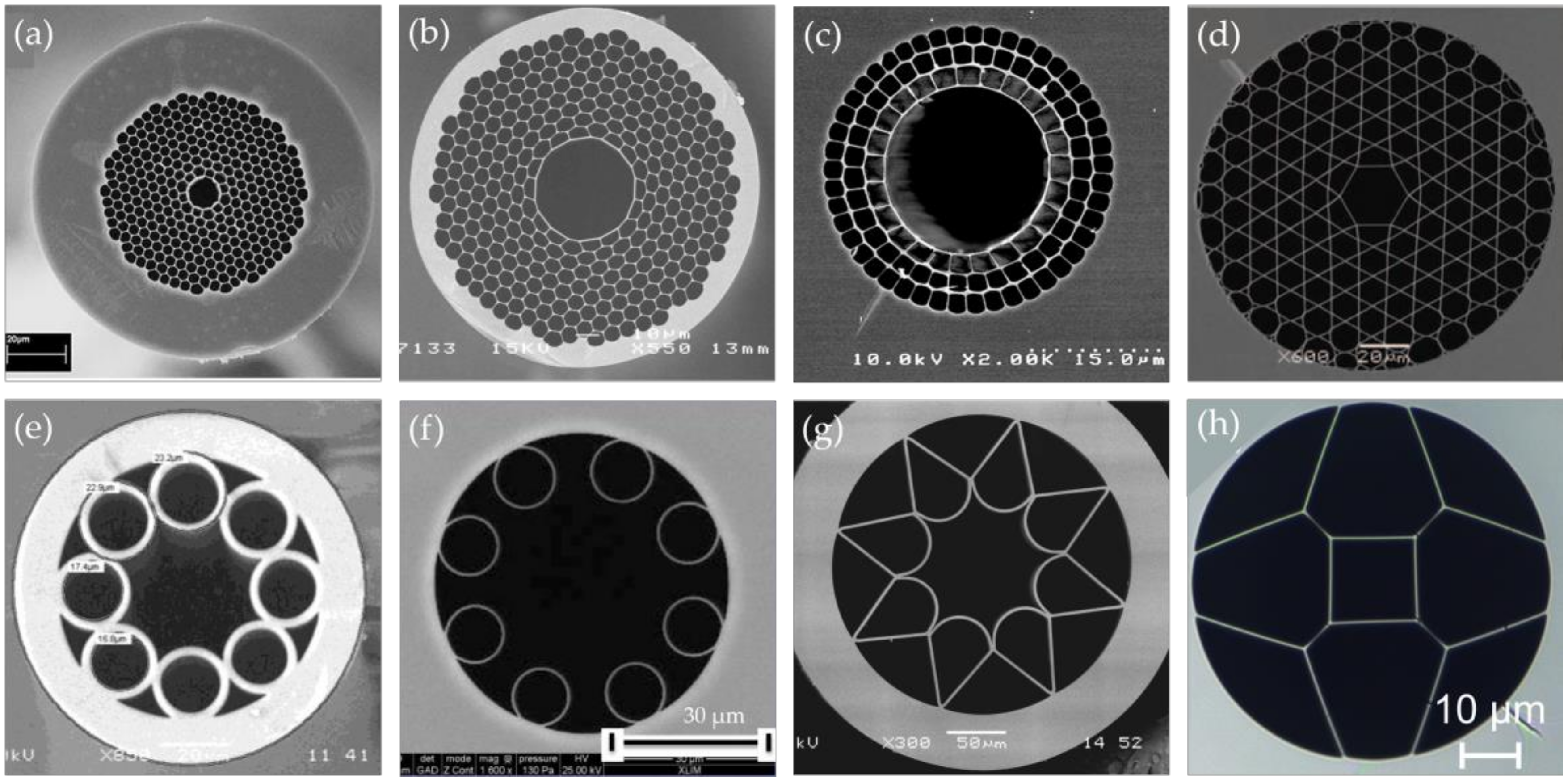
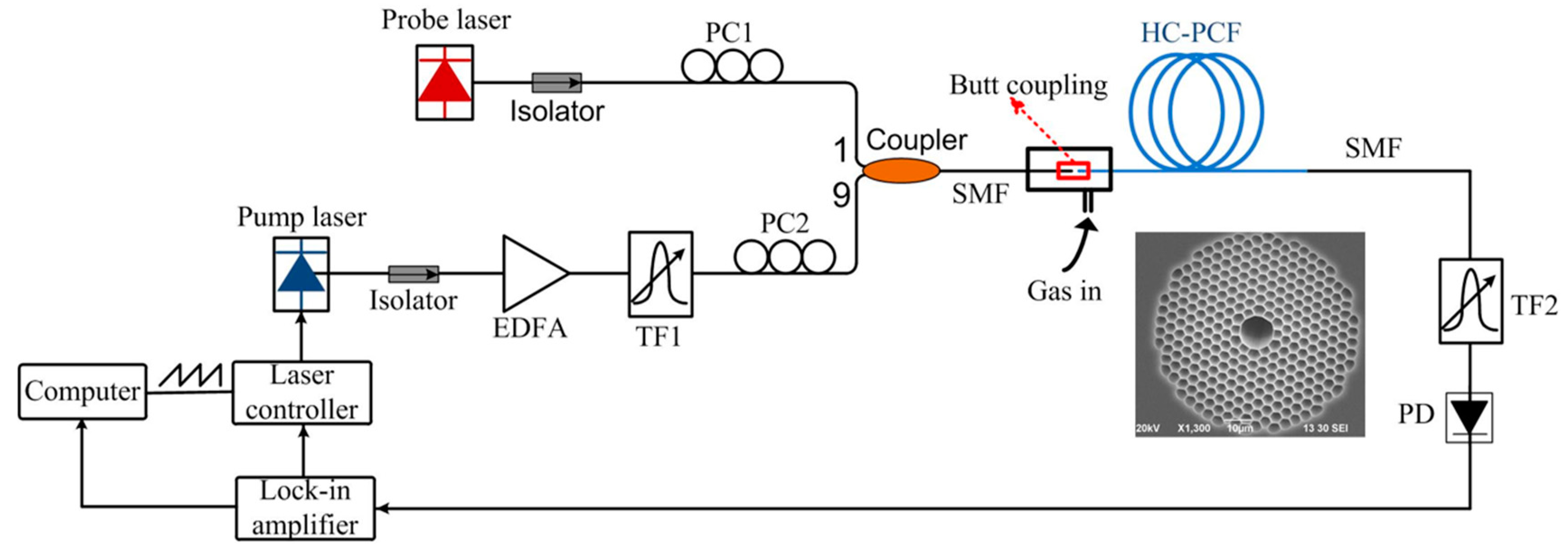


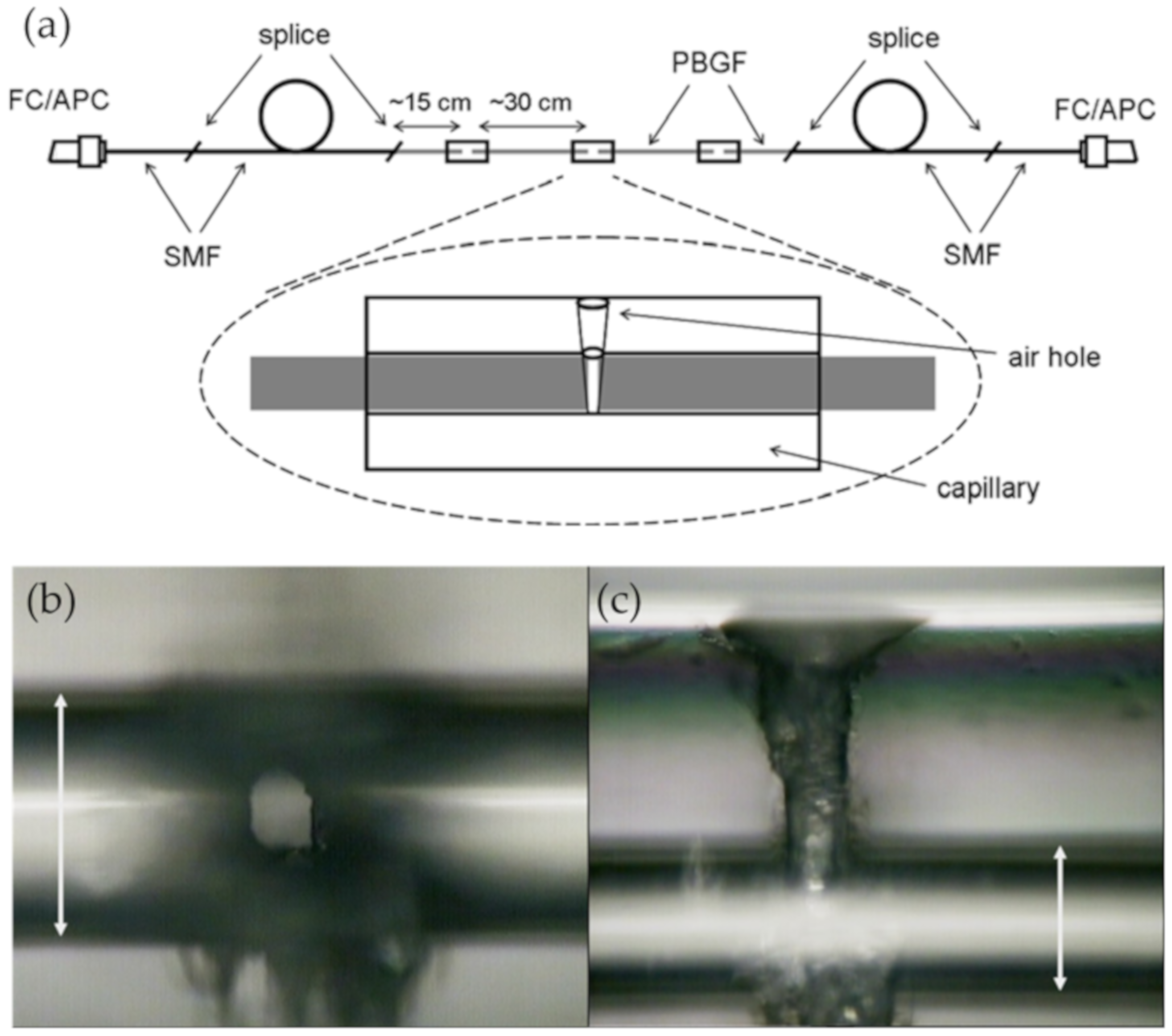

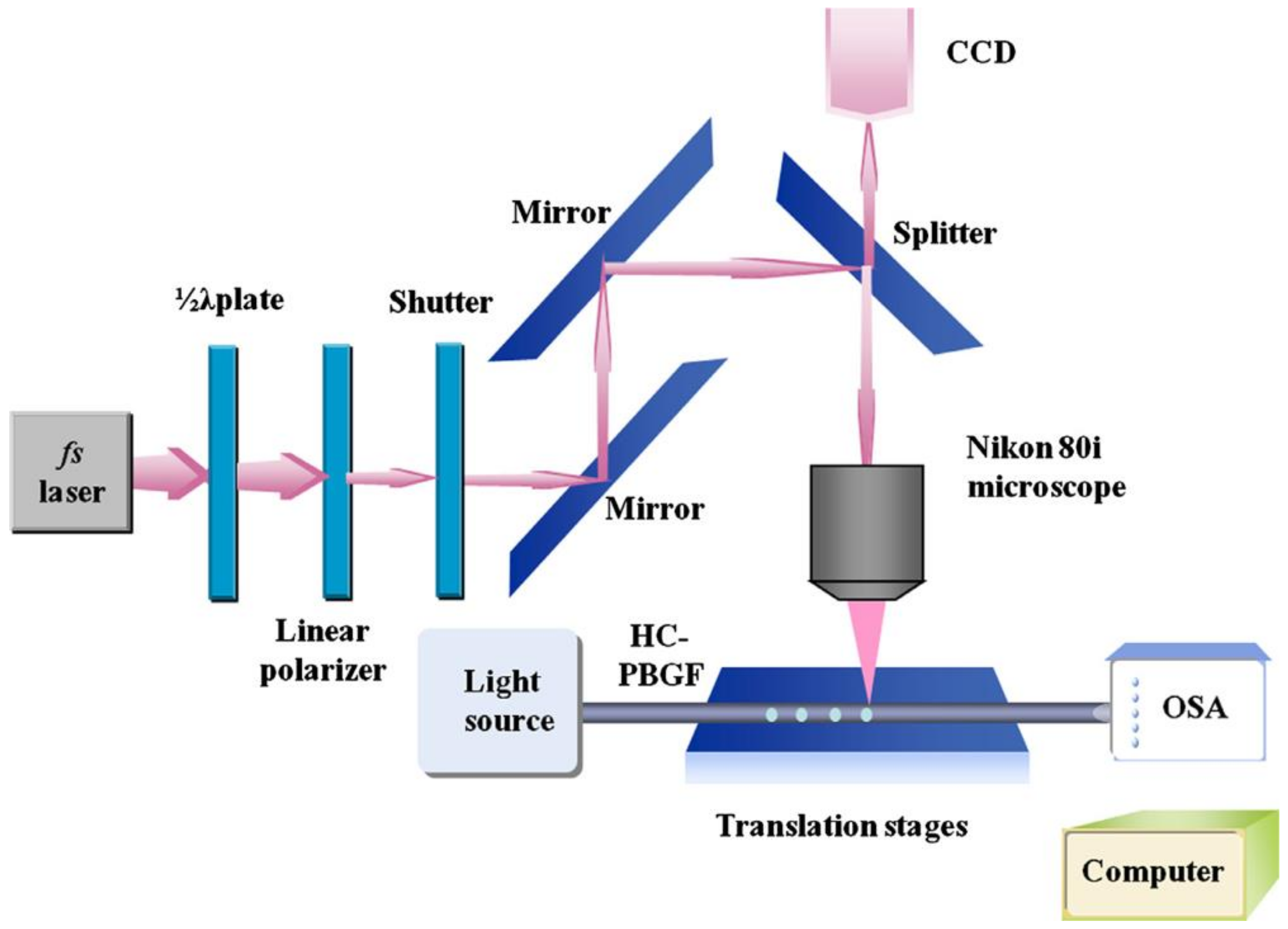
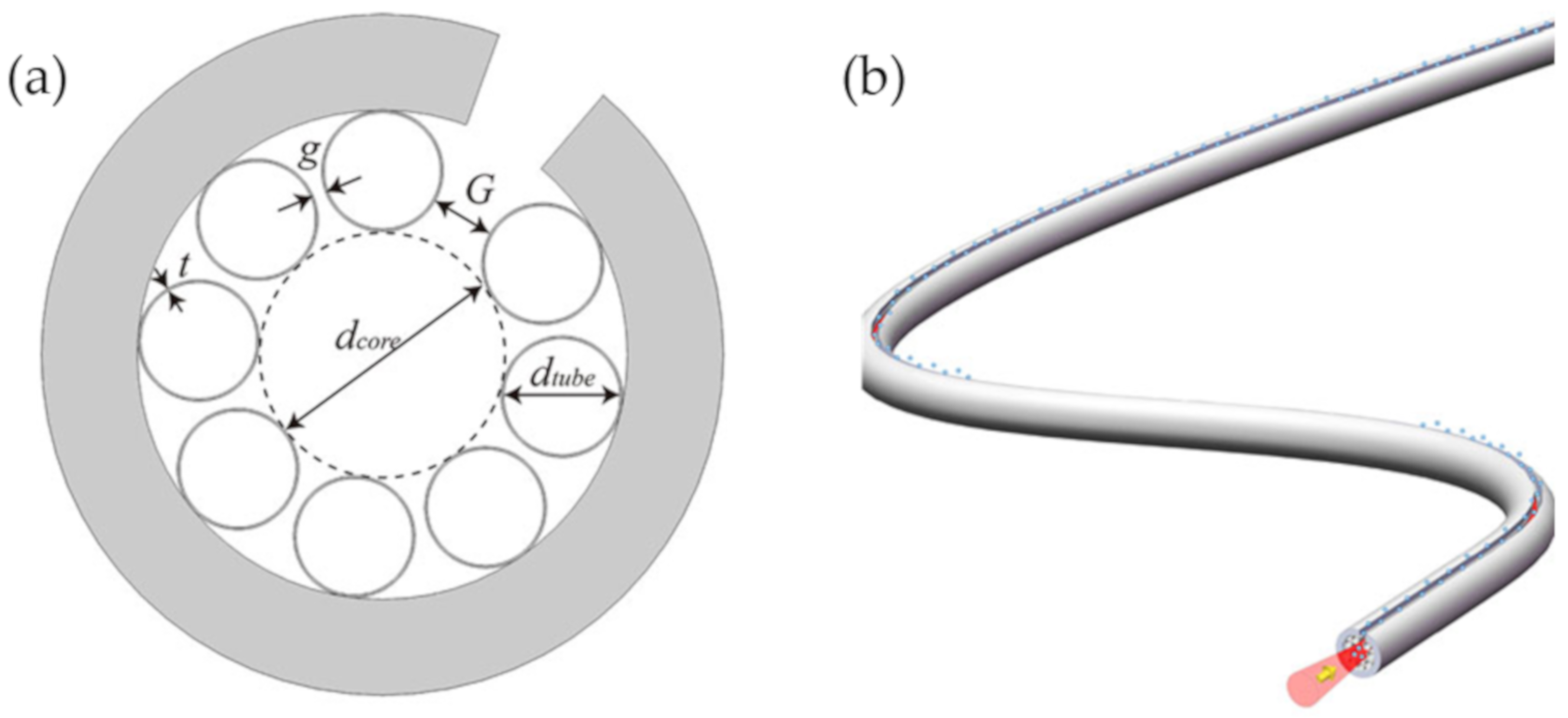

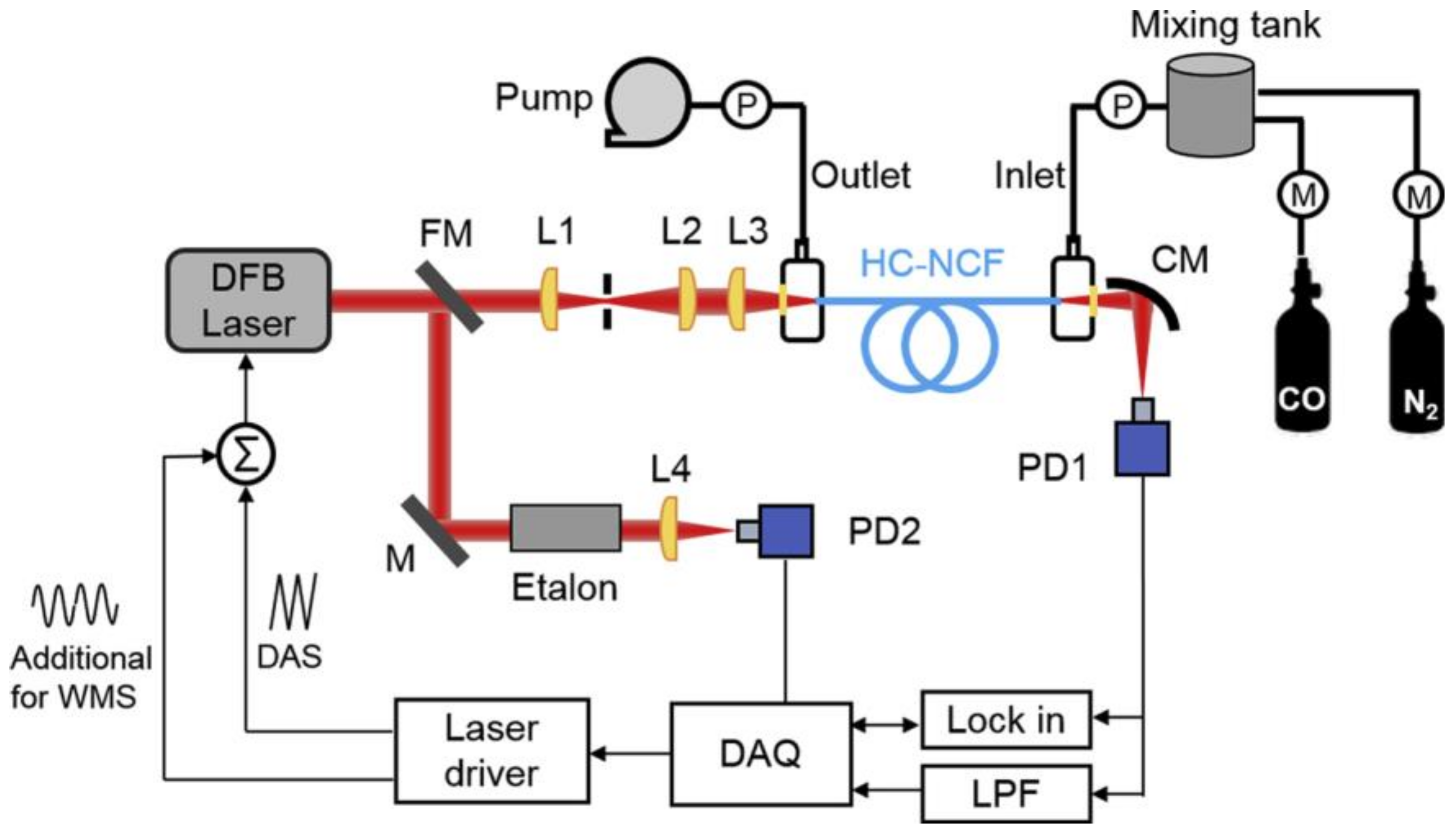

| Gas | Absorption Line Wavelength (nm) | Line Strength (cm−1/molecule·cm−2) |
|---|---|---|
| Acetylene (C2H2) | 1533 | 8.07 × 10−21 |
| Ammonia (NH3) | 1544 | 3.73 × 10−22 |
| Carbon monoxide (CO) | 1567 | 2.32 × 10−23 |
| Carbon dioxide (CO2) | 1573 | 1.94 × 10−23 |
| Hydrogen sulfide (H2S) | 1578 | 1.31 × 10−22 |
| Methane (CH4) | 1330 | 1.21 × 10−22 |
| Methane (CH4) | 1667 | 6.05 × 10−22 |
| Water (H2O) | 1365 | 2.12 × 10−20 |
© 2020 by the authors. Licensee MDPI, Basel, Switzerland. This article is an open access article distributed under the terms and conditions of the Creative Commons Attribution (CC BY) license (http://creativecommons.org/licenses/by/4.0/).
Share and Cite
Yu, R.; Chen, Y.; Shui, L.; Xiao, L. Hollow-Core Photonic Crystal Fiber Gas Sensing. Sensors 2020, 20, 2996. https://doi.org/10.3390/s20102996
Yu R, Chen Y, Shui L, Xiao L. Hollow-Core Photonic Crystal Fiber Gas Sensing. Sensors. 2020; 20(10):2996. https://doi.org/10.3390/s20102996
Chicago/Turabian StyleYu, Ruowei, Yuxing Chen, Lingling Shui, and Limin Xiao. 2020. "Hollow-Core Photonic Crystal Fiber Gas Sensing" Sensors 20, no. 10: 2996. https://doi.org/10.3390/s20102996






